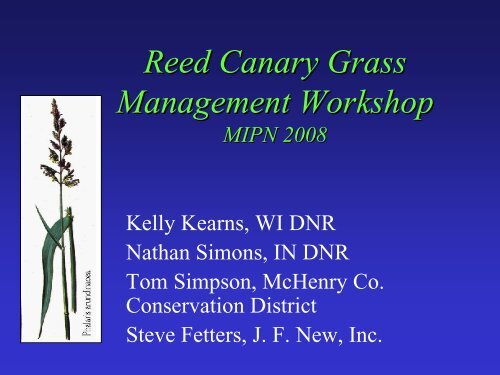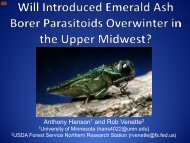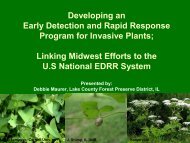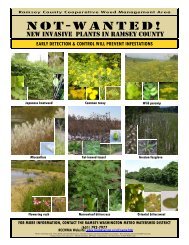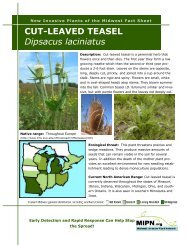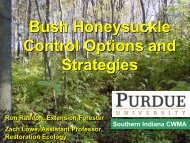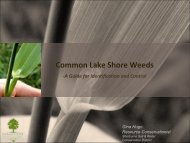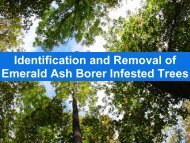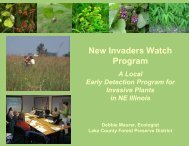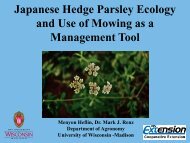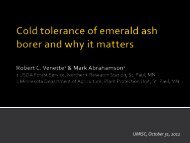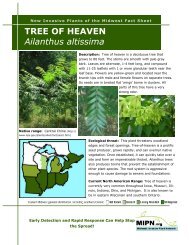Reed Canary Grass Management Workshop
Reed Canary Grass Management Workshop
Reed Canary Grass Management Workshop
- No tags were found...
Create successful ePaper yourself
Turn your PDF publications into a flip-book with our unique Google optimized e-Paper software.
<strong>Reed</strong> <strong>Canary</strong> <strong>Grass</strong><strong>Management</strong> <strong>Workshop</strong>MIPN 2008Kelly Kearns, WI DNRNathan Simons, IN DNRTom Simpson, McHenry Co.Conservation DistrictSteve Fetters, J. F. New, Inc.
Overview of RCG Methods of Spread+ Summary of Recent ControlBased Research- Craig A. Annen, Integrated Restorations, LLC(608) 424-6997annen00@aol.com- Chris Reyes, University of Wisconsin-Madison- Joy Zedler and many studentsUniversity of Wisconsin-Madison
Invasion MechanismsTwo components to RCG invasion:1. Site disturbances2. Invasive/competitive characteristics of RCGNew RCG invasion requires disturbances thatcreate bareground areasMultiple disturbances interact synergisticallyto accelerate the rate of invasionLindig-Cisneros & Zedler (2001 et seq.)
Characteristics of highly competitive species(Grime 1973; Prach & Pysek 1999)1. Tall perennial2. Wind-pollinated3. Responds positively tonutrient enrichment4. Responds to soilmoisture5. Capable of intenselateral spread6. Plastic response toenvironmentalvariability7. Long growing period8. Tendency to deposit adense litter layer9. High potential growthrate
Der Rat beschließt einstimmig:1) Zur Vermeidung jedweden Risikos werden die städtischen Anteile am KVR-Fonds zum nächstmöglichen Zeitpunkt veräußert.2) Es erfolgen keine freiwilligen Zuführungen zum KVR-Fonds (Kauf vonFondsanteilen).3) Hauptausschuss und Rat sind über die Höhe der Einzahlungen aus derVeräußerung sowie die Ergebnisauswirkungen dieses Verkaufs zuunterrichten.4) Der Erlös aus dem Verkauf ist zur Haushaltskonsolidierung einzusetzen.7. Genehmigung einer Dringlichkeitsentscheidung:hier: Mittelbereitstellung für die Ersatzbeschaffung eines SoletanksBeschluss:Der Rat genehmigt einstimmig die vom 1. Beig. und Kämmerer Dr. W. Zimdarsund dem Ratsmitglied Grüttemeier getroffene dringliche Entscheidung zurMittelbereitstellung in Höhe von 60.000,-- zur Ersatzbeschaffung einesSoletanks beim Produkt 5.68.0005510720 Bewegliches AnlagevermögenStraßenreinigung.8. Mitgliedschaft der Stadt Stolberg in der “Energeticon gemeinnützige GmbH” -Änderung des GesellschaftsvertragesBeschluss:Der Rat nimmt die Änderungen im Entwurf des Gesellschaftsvertrages zur“Energeticon gGmbH” mit 39 Ja-Stimmen (BM, SPD, CDU, B’90/Grüne, LINKE, RMEmonds, RM Kunkel) und 4 Nein-Stimmen (FDP) zustimmend zur Kenntnis.Der Rat beschließt im gleichen Stimmenverhältnis, dass die Stadt StolbergMitglied der Energeticon gGmbH” unter Maßgabe des geändertenGesellschaftsvertrages wird.Der Anteil der Stadt Stolberg am Stammkapital soll 2,5% betragen (entspricht650,-- ). Sollte im Laufe der Verhandlungen zum Gesellschaftsvertrag der Anteilder Stadt Stolberg am Stammkapital 5% übersteigen oder sonstige wesentlichenÄnderungen im Gesellschaftervertrag gegenüber der jetzt vorliegendenEntwurfsfassung vorgenommen werden, wird die Verwaltung einen neuenBeschluss herbeiführen.9. Bebauungsplan Nr. 68 “Brockenberg”, 2. Änderunghier: Vorstellung des Entwurfs und Beschluss über die öffentliche Auslegung gem.§ 3 (2) BauGBBM Gatzweiler informiert den Rat über die Beschlussfassung im ASVU und HA. Hierwar der Alternativantrag (Ablehnung der Dreigeschossigkeit und Mindestgebäudebreitein den textlichen Festsetzungen) der CDU-Fraktion mehrheitlich abgelehnt worden.6
• RCG displays aconsolidation strategy(Maurer & Zedler 2002)• Spot expansion tillers donot require baregrounddisturbanceLeading Edge(clonal patch)Invasion FrontSpotExpansionClones
What makes RCG controlso difficult?
Challenges of RCG Control• Expensive• Often too costly or impractical to ameliorateunderlying causes of invasions• Difficulty reestablishing native species undersome treatment regimes• Secondary outbreaks of other invasives• RCG is ubiquitous in the landscape• Requires multiple-year effort• Nonselective herbicides can eliminate non-targetspecies
Resurgence Mechanisms in RCG- The ability to recover from treatments1. Active seed bank• 31 – 437 viable seeds/m 2• Estimated viability: 2 years (Comes et al. 1978)2. 3000 – 6500 buds/m^2 (Reyes, 2004)3. Rhizome apical dominance• 47 – 76% of rhizome buds in a RCG populationare metabolically dormant (Reyes 2004)• Herbicides translocate only to apex due to apicaldominance; most lateral buds are unaffected andcan resprout.
Dormant budDuringApplication14C glyphosate14C sethoxydimCH 2 O/herbicideActive budPost-Application·Apex and distal buds killed·RCG resprouts from lateral buds
Short-Circuiting ApicalDominance (AnnenAnnen, , 2008)1. Tillage (followed by herbicide app.)• Decapitate rhizomes to encourage lateral growth
Tillage + Sethoxydim(Annen 2008)• Pretreatment rotovation enhancedRCG suppression with sethoxydim:35% greater suppression after one year35%443% after two consecutive years443% after two consecutive years• Tillage also enhanced native speciesabundance (up to 127%) and diversity(up to 87%)
Tillage + Glyphosate(Kilbride & Paveglio 1999; Paveglio & Kilbride 2000)• Disking enhanced RCG suppression withglyphosate36 – 90% greater suppression than herbicideonly after one year of treatments• Tillage also enhanced native speciesrichness (up to 379%) and diversity (upto 302%)
RCG Resurgence Capacity(1-year post treatment)• Tillage + sethoxydim reduced RCGresurgence capacity 228% greater thanherbicide application aloneIn general, coupling tillage to herbicideapplication results in longer carryovereffects than solitary herbicide use
Herbicide OnlyTill & Herbicide
Tillage has drawbacks…• Destroys microtopographic heterogeneityand homogenizes soil variability• Repeated tillage can compact and clod soil• Disrupts VAM colonization• Limited by site accessibility and/or siteconditions• Can surface weed seeds, especially inrestored landscapes
Are there any no-till methodsfor short-circuiting apicaldominance?
Short-Circuiting Apical DominancePlant Growth Regulator (PGR(PGR)Pretreatments• Plant hormone analog sends falsemolecular signal for rhizome to initiatelateral growth• Distributes herbicide more uniformlywithin rhizome(Annen,, 2008)
4,000 ppm 2:1 CCC/ethephon (May)Control“Activated” lateralrhizome buds
RCG Resurgence Capacity(1-year post treatment)The ability to recover from treatments• CCC/ethephon pretreatment reducedRCG resurgence capacity 26%2008)26% (Annen• Kinetin pretreatment reduced resurgencecapacity 169% (Annen, in progress)
Cost Analysis• Sethoxydim application only $100/acre(3.75 pints/acre)• Tillage & sethoxydim application $140/acre(3.75 pints/acre)• CCC/ethephon & sethoxydim $530/acre(1.25 pints/acre and 3.75 pints/acre)• Kinetin & sethoxydim application $115/acre(Paired apps @ 1 pint/acre and 3.75 pints/acre)
Treatment responses oftendepend upon initial siteconditions
PGR + Sethoxydim plot(Complex, multi-layered canopy)Most positive response to treatments
PGR + Sethoxydim plot(Mixture of sedges and RCG)Intermediate response to treatments
PGR + Sethoxydim plot(RCG-dominated)Least positive response to treatments
Which sites are worth the effort and cost?• Mixed stands –
Synergizing Treatments with IntegratedControl Programs• Rx fire only: Negligible effects (Reyes 2004)• Mow only: Increase in stem density (Tu,, 2006)• Till only: 61% increase in stem density (Kilbride &Paveglio 1999)• Herbicide only: 50% suppression (Annen et al. 2005)• Rx fire + herbicide: 40% increase in suppressionover herbicide only (Healy & Zedler, in progress)• Till + herbicide: 443% increase in suppression c.f.herbicide only (Annen 2008)• Rx fire + till + herbicide: 2,100% increase insuppression c.f. herbicide only (Annen, in progress)
Field conditions can affect herbicide• Temperatureperformance• Affects translocation patterns of sethoxydim andglyphosate• UV Radiation• Degrades sethoxydim, clethodim, and imazapic• Do not apply during mid-day day or on bright, sunny days• Methylated vegetable oils offer some protection• Inclement Weather• Precipitation deficits, precipitation surpluses, stress,inactive growth, etc.
Additives Enhance HerbicidePerformanceHard water cationsInactivate herbicidesand accelerate physicaland chemicaldecompositionWater conditioning agents,acidifiers, or AMS Add to tank mixturesBEFORE herbicide
Additives Enhance HerbicideSurfactantsPerformance• Enhance uptake and translocation of herbicides by reducingsurface tension of spray mixtures• Herbicide spray comes in contact with a larger surface area ofthe leafCrop Oils• Dissolve the leaf cuticle to promote greater absorption Tip: Spend the extra money on refined crop oil blends; theseare less apt to clog spray nozzles
Additives Enhance HerbicidePerformanceSurfactant-Crop Oil Blends***The best option for RCG control***• Combine the surface tension-reducing properties ofsurfactants with the cuticular-penetrating properties ofcrop oils• Methylated surfactant-oil blends also offer someprotection from UV degradation• Generally inexpensive: ca. 10 cents per mixed gal.
Additives Enhance HerbicidePerformanceWARNING!!!> Herbicide-additive tank mixtures haveLIMITED shelf life. Mix only as much asyou intend to use each day.
Spring or Autumn Applications?(Annen, in preparation)1. Increase in effects size of autumn treatments isonly 15%2. Resurgence occurs regardless of season ofapplication3. Fall applications enable anthesis and seed set4. RCG leaf growth predominates in spring; stemgrowth in autumn5. Senescence and inactive leaf growth in autumn
Spring or Autumn Applications?(Annen, in preparation)6. Leaf cuticles are thicker in late summer andautumn (less herbicide penetration)7. Greater volume of plant material in autumn(herbicide is diluted within plant)8. Rhizome carbohydrate reserves are minimum inspring/early summer (etiolated regrowth is only0.04 g in June)9. RCG max productivity is in mid-June
Spring or Autumn Applications?(Annen, in preparation)10. Rhizome apical dominance is most pronouncedduring tillering11. Late season applications do not allow for nativespecies release (competition augments treatmenteffects)12. RCG can enter quasi-dormancy during hotsummer/autumn months13. Lodging and blowdown reduce herbicideperformance
Spring or Autumn Applications?(Annen, in preparation)14. Greater volume of herbicide required for lateseason treatments (adds to cost)15. Herbicide treatments at flowering may stressRCG and hinder resurgence more that at otherstages (energy investment has been channeledinto flowering and seed development)16. Seedlings are eliminated by spring applications;seedlings are allowed to tiller by autumnapplications
Spring or Autumn Applications?(Annen, in preparation)17. Seeds shatter over equipment and clothing,increasing the chance of contaminating othersites18. Site accessibility and ease of application arelower in late summer and autumn (dense, lodgedRCG hides obstacles that can damageequipment)19. Safety – Late season applications increase therisk of chemical exposure20. Nesting birds can be disturbed by late seasonapplications


